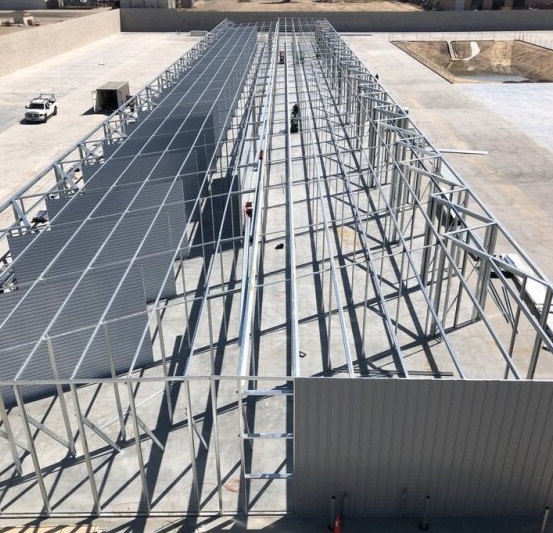
When deciding to develop a new self-storage facility, it can be an exciting time coming up with ideas and thinking about the future of the business. But before it comes to that, the facility must first become a reality. Making your new project a reality will take time, but how much time exactly does it take and what factors come into play?
The process of developing and constructing a self-storage facility can be broken down into five main stages:
- Planning and Feasibility: This stage involves market research, site selection, and feasibility studies. You'll need to determine the demand for self-storage in your area, identify the right location, and develop a detailed plan for your facility.
- Design and Permitting: Once you have a solid plan, you'll need to hire an architect and engineer to design your facility. You'll also need to obtain all necessary permits from your local municipality.
- Financing: Securing financing is a critical step in the development process. You'll need to work with a lender to get the funds you need to cover the cost of construction.
- Construction: Once you have your financing in place, you can begin construction. This stage typically takes 6-16 months, depending on the size and complexity of your facility.
- Marketing and Opening: Once your facility is complete, you'll need to start marketing it to potential customers. You'll also need to develop operational procedures and hire staff.
The timeline for the pre-construction phases (planning and feasibility, design and permitting, and financing) can vary greatly depending on the area you are planning to build in, the scope of the project, and personal finances. For example, building a small single-story facility in a rural area may get designed, financed, and approved much faster than a large, complex multi-story facility in an urban area. But that may not be the case every time, and the pre-construction timeline for one facility may be different from another facility in the same area built at a different time. Zoning may also add time as the land you are working with may not be zoned for self-storage and may have to be re-zoned with the city.
A Closer Look at the Construction Timeline
The construction timeline for a self-storage facility can vary depending on a number of factors, such as the size of the facility, the complexity of the design, and the availability of materials and labor. While the size and complexity of each building design will affect the time needed for erection, there is a general rule of thumb. For scheduling purposes, estimate that an experienced crew of five including a lead should erect approximately five thousand square feet of building per week. This does not include roll-up doors or the interior hallway system. Add at least one week to the total schedule to allow for “punch list” items. Depending on the size of the facility can be you can expect construction to take about 6-16 months.
Here's a breakdown of the typical construction timeline for a self-storage facility (Please note: these are average time frames. These may be longer or shorter depending on location, scope of work, weather, supply chain issues, etc):
- Site preparation: 2-4 weeks
- Foundation: 4-6 weeks
- Framing and roofing: 4-6 weeks
- Exterior finishes: 4-6 weeks
- Interior finishes: 6-8 weeks
- HVAC and electrical: 4-6 weeks
- Security systems: 2-4 weeks
- Landscaping and paving: 2-4 weeks
Tips for Keeping Your Project on Track
Developing and constructing a self-storage facility is a complex process with a lot of moving parts. With time being a critical factor, here are some tips to help your project stay on track:
- Hire a qualified team: Assemble a team of experienced professionals, including an architect, engineer, contractor, and lender.
- Develop a detailed plan: Create a comprehensive plan utilizing a general contractor that outlines your budget, timeline, and milestones.
- Communicate effectively: Maintain clear and consistent communication with all stakeholders involved in the project.
- Be flexible: Expect the unexpected and be willing to adapt your plans as needed.
The proper scheduling of all of the trades involved can also affect schedules. We at MakoRabco have sometimes found our crews delayed by electricians, heating and cooling system installation, or drywall. We always make an extra effort to coordinate our work with the other trades. There is no need for one trade to have to be completely finished with their phase of work in order for another trade to begin theirs. Proper project management and scheduling can help in avoiding these delays. Companies you are working with may have other branches of their company that can help streamline processes by limiting the amount of different companies to coordinate. For example, we at MakoRabco have an in-house doors and hallways division that can design and procure your doors and hallways for you, streamlining the process.
Weather conditions must always be taken into consideration as well. In most parts of the country, especially during certain seasons, weather delays can be expected. Mud is one of the most difficult conditions to build in. Surprisingly, it is easier to build in snow or heat than it is to work in mud. Proper site maintenance while building is crucial to mitigate issues.
Building a self-storage facility can be a rewarding experience, but it's important to be realistic about the time and effort involved. By understanding the average timelines and following the tips above, you can increase your chances of success.
Interested in developing a self storage facility? Download our self storage development guides here!
